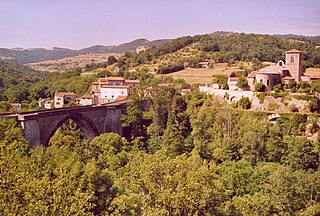
The Serchio is the third longest river in the Italian region of Tuscany at 126 kilometres (78 mi), coming after the Arno at 242 kilometres (150 mi) and the Ombrone, 161 kilometres (100 mi). By mean rate of flow, it is the second largest, smaller than Arno but larger than Ombrone.

Borgo a Mozzano is a town and comune in the province of Lucca, in northern Tuscany (Italy), located on the Serchio River.

Devil's Bridge is a term applied to dozens of ancient bridges, found primarily in Europe. Most of these bridges are stone or masonry arch bridges and represent a significant technological achievement in ancient architecture. Due to their unusual design, they were an object of fascination and stories in antiquity and medieval Europe.

Gallicano is a comune (municipality) in the Province of Lucca in the Italian region Tuscany, located about 70 kilometres (43 mi) northwest of Florence and about 25 kilometres (16 mi) northwest of Lucca.

The Bridge of Tiberius, historically also the Bridge of Augustus or the Bridge of Saint Julian, is a Roman bridge in Rimini, in the region of Emilia-Romagna, northern Italy.

The Alconétar Bridge, also known as Puente de Mantible, was a Roman segmental arch bridge in the Extremadura region, Spain. The ancient structure, which featured flattened arches with a span-to-rise ratio of 4–5:1, is one of the earliest of its kind. Due to its design, it is assumed that the bridge was erected in the early 2nd century AD by the emperors Trajan or Hadrian, possibly under the guidance of Apollodorus of Damascus, the most famous architect of the time.

The Trezzo sull'Adda Bridge or Trezzo Bridge was a medieval bridge at Trezzo sull'Adda in Lombardy, Italy, spanning the Adda river. Completed in 1377, the single-arch bridge held the record for the largest span for over four hundred years, until the beginnings of the Industrial Age, while it was not until the early 20th century that masonry bridges with larger openings were constructed.

The Pont du Diable or Pont Vieux is a medieval stone arch bridge at Céret, France, built between 1321 and 1341. It spans the Tech River with a single arch of 45.45 metres (149.1 ft). At its apex, the arch is 22.3 metres (73 ft) high.

The Pont Grand is a stone bridge connecting Tournon-sur-Rhône to Saint-Jean-de-Muzols, in Ardèche, France, built between 1379 and 1583. The bridge features a single, semi-circular arch over the river Doux with a span of 49.20 m. The height of the piers is 17.73 m.

The Puente de San Martín is a medieval bridge across the river Tagus in Toledo, Spain.

The Pont del Diable, also known as Sant Bartomeu Bridge, is a medieval bridge crossing the river Llobregat and straddling the municipalities of Martorell and Castellbisbal in Catalonia, Spain. The bridge is restricted to pedestrians.

Pont de Vieille-Brioude is located in France, crossing the river Allier. It is a masonry arch bridge with a span of 45 metres (148 ft) that was built in 1832.

The Nyons Bridge is a medieval bridge over the river Eygues in Nyons in southern France.

A bridge tower was a type of fortified tower built on a bridge. They were typically built in the period up to early modern times as part of a city or town wall or castle. There is usually a tower at both ends of the bridge. During the 19th century, a number of bridge towers were built in the Gothic Revival style – Tower Bridge in London is perhaps the best known example; however, many original medieval towers survive across Europe.

The Ponte della Maddalena was a bridge on the south east of Naples, Italy, spanning over what was once the River Sebeto, and now reflected by the path of the Via Marinella. For centuries it was one of the entry points into Naples from the South, but was obliterated during the late 19th-century urban renewal of the city.

The Lucca-Aulla railway also known as the Garfagnana railway is an Italian railway branch line. Running from the city of Lucca the line crosses the Garfagnana and Lunigiana regions to join the Parma–La Spezia railway in Aulla.

















